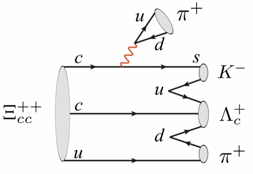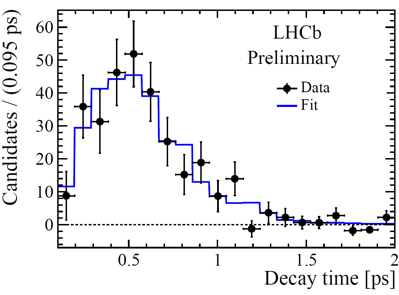[ τ(Ξcc++) = 0.256+0.024-0.022±0.014 ps ]
Last year the LHCb Collaboration announced the observation of an exceptionally charmed particle, the Ξcc++ baryon. This contains two charm quarks and one up quark, resulting in an overall doubly positive charge. The Ξcc++ baryon was identified via its decay into a Λc+ baryon and three lighter mesons K–, π+ and π+ (see graph), with the Λc+ baryon decaying in turn into a proton p, a K– and a π+ meson. Following this observation, LHCb is now undertaking precision studies of the properties of this special particle. These studies are made possible by the high production rate of heavy quarks at the LHC and the unique capabilities of the LHCb experiment, which can identify the decay products with excellent efficiency and purity. The precise measurements of the track trajectories by the LHCb Vertex Locator (VELO) enable the reconstruction of the proton-proton collision point, marked as “PV”, and of the decay points of the Ξcc++ and Λc+ baryons, as seen in the cartoon.
This week, at the 9th International Workshop on Charm Physics, CHARM 2018, in Novosibirsk, Russia, the LHCb Collaboration has presented the first measurement of the lifetime of the Ξcc++ baryon. The data sample and the event selection are similar to those used in the analysis of the Ξcc++ discovery. The experimental technique is based on the measurement of the decay time distribution relative to that of another decay with a similar topology, Λb0 → Λc+π–π+π–. As the lifetime of the Λb0 is already known with high precision from previous measurements, once the ratio of efficiencies for reconstructing the Ξcc++ and Λb0 decays is determined, it is possible to derive the lifetime of the Ξcc++ baryon. This approach allows for significant reductions of the systematic uncertainties associated to the measurement. The image shows the background-subtracted decay time distribution of the reconstructed Ξcc++ baryons marked as “Data” points. The “Fit” distribution is created with the lifetime parameter adjusted to describe (fit) the data in the best possible way. The lifetime value obtained from the fit is 0.256+0.024-0.022±0.014 ps.
The measurement of the lifetime is critical to establish the nature of the Ξcc++. The result clearly confirms predictions that it would have a relatively long lifetime value, which is a distinctive feature of weak interactions. However, it is very difficult to provide precise theoretical predictions, and thus they span a wide range, between 0.200 and 1.050 ps, depending on the phenomenological model that is used. The value measured by LHCb is within this range, but close to the lower end.
Read more in the LHCb presentation, in the CERN update in English and French, in the LHCb paper, and also in the CERN Courier article.



